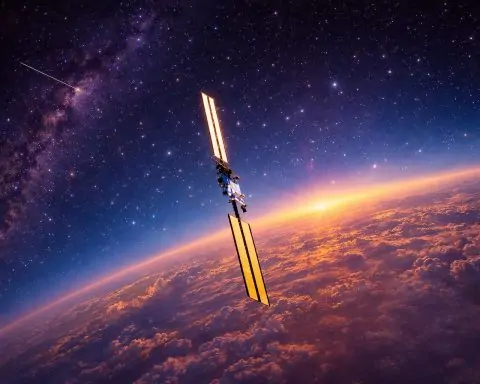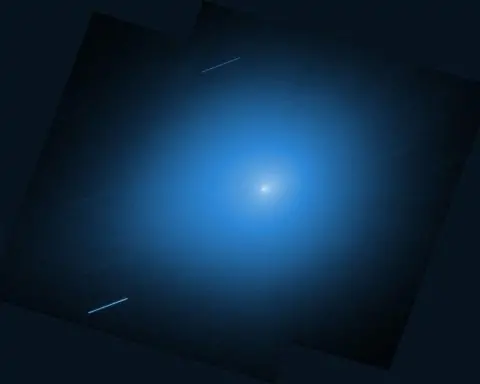- SpaceX conducted a secret Falcon 9 launch from Florida on July 13, 2025 carrying Israel’s Dror-1 communications satellite into geostationary transfer orbit, a $200 million “smartphone in space” project that will provide Israeli communications for 15 years, with the first stage landing on a droneship for the rocket’s 13th successful reuse.
- China rolled out Long March-7 Y10 and Tianzhou-9 to the Wenchang launch pad on July 12, 2025 to deliver about 6.5 tons of supplies to Tiangong for the Shenzhou-20 mission, including two upgraded spacesuits and a backup Long March-7 within three months.
- Rocket Lab launched its HASTE suborbital rocket from Wallops Island, Virginia on July 12, 2025 at 7:45 p.m. EDT carrying a classified payload codenamed JAKE-4 to support hypersonic and defense technology experiments for the Pentagon.
- SpaceX’s Starlink Direct-to-Cell service is slated for July 2025, enabling smartphones to connect directly to Starlink satellites for texts, calls, and basic data via an API, using more than 657 next-generation Starlink V3 satellites as space-based cell towers.
- India’s IN-SPACe granted Starlink a 5-year commercial operating license on July 9, 2025, making Starlink the third entity authorized for broadband-from-space in India and requiring spectrum allotments and ground stations.
- In Europe, the EU IRIS² program saw France-based Eutelsat demonstrate a standard 5G smartphone connecting directly to a satellite network, marking a world-first milestone in satellite-assisted 5G.
- China Telecom unveiled direct-to-satellite consumer services on July 11, 2025, offering smartphone-to-satellite messaging, vehicle-mounted satellite links, and Tiantong L-band applications, signaling a mass-market shift in satellite communications.
- Firefly Aerospace filed for an initial public offering on July 12, 2025 to raise capital for scaling launches and developing a new medium-lift vehicle around its Alpha rocket.
- Varda Space Industries raised $187 million in a Series C round announced on July 11, 2025 to fund in-space manufacturing of pharmaceuticals and materials in small capsules before returning them to Earth.
- A 1964 Relay 2 satellite near-Earth radio burst was detected in June 2024 after decades of silence, prompting space-debris and orbital-operations discussions as researchers note the potential risks posed by long-lived “space relics.”
Satellite News Roundup for July 12–13, 2025
The past 48 hours delivered a blitz of satellite news across the globe. From a stealth SpaceX launch of a “smartphone in space” to international plans for new orbiting networks, this weekend saw major developments in civilian, commercial, scientific, and military space arenas. Here’s a comprehensive roundup of everything you need to know, complete with expert quotes and official statements, on satellite launches, breakthroughs, anomalies, and policy moves around the world.
Major Launches and Satellite Deployments
- SpaceX’s Secret Launch Revealed – Israel’s “Smartphone in Space”: Early Sunday (July 13), SpaceX conducted a hush-hush Falcon 9 launch from Florida, carrying Israel’s new Dror-1 national communications satellite into geostationary transfer orbit [1] [2]. The mission (coded Commercial GTO-1) had a veil of secrecy until Israel Aerospace Industries (IAI) confirmed the payload post-launch. Dror-1, billed as a $200 million “smartphone in space” by Israel’s Foreign Ministry, will provide Israel’s strategic and civilian communications for the next 15 years [3]. IAI called it “the most advanced communication satellite ever built in Israel,” highlighting its state-of-the-art digital payload and modular design [4] [5]. SpaceX landed the Falcon 9’s first-stage booster on a droneship after liftoff, marking the rocket’s 13th successful reuse [6] [7]. Boaz Levy, IAI’s CEO, applauded the launch as a “historic leap for Israeli space technology,” underscoring the importance of maintaining independent national space capabilities [8].
- China Prepares Cargo Craft Launch for Space Station: Above: China’s Long March-7 Y10 rocket with Tianzhou-9 cargo spacecraft rolls out to the Wenchang launch pad on Hainan Island, July 12, 2025 [9]. On Saturday, China rolled out its Tianzhou-9 cargo spaceship and Long March-7 Y10 rocket to the launch pad at Wenchang Space Launch Center [10]. The China Manned Space Agency announced that all systems are in good condition and the craft will launch in coming days to deliver ~6.5 tons of supplies to the Tiangong space station [11] [12]. This mission will ferry essentials for the Shenzhou-20 crew, including two new spacesuits (upgraded for 20 spacewalks) and scientific equipment [13] [14]. It marks the ninth Tianzhou resupply flight, critical for sustaining China’s orbiting station. (Notably, China also kept a backup Long March-7 ready on standby in case an emergency launch is needed within 3 months [15] [16]—a sign of how robust its human spaceflight logistics have become.)
- U.S. Military Test Launch by Rocket Lab: On July 12, Rocket Lab conducted a launch from Wallops Island, Virginia, of its HASTE suborbital rocket carrying a classified U.S. government payload code-named JAKE 4 [17]. Liftoff occurred at 7:45 p.m. EDT, and while details remain secret, HASTE (Hypersonic Accelerator Suborbital Test Electron) missions are known to support hypersonic and defense technology experiments for the Pentagon. The use of a commercial small launch vehicle for a military test underlines the growing role of private launch providers in defense programs [18]. This is one of several Space Force and Defense Department efforts to leverage commercial rockets for rapid test capabilities.
Commercial & Industry Updates
- Starlink Direct-to-Cell Service Debuts: SpaceX’s Starlink is poised to eliminate mobile dead zones with a new Direct to Cell service launching this month. Starting July 2025, Starlink (in partnership with T-Mobile) will allow regular smartphones to connect directly to its satellites for text messaging, voice calls, and even basic data (apps like WhatsApp and Google Maps) [19]. Over 657 next-gen Starlink V3 satellites will act as “space-based cell towers” providing coverage where terrestrial networks don’t reach [20]. Developers can use Starlink’s new API to optimize apps for satellite connectivity, and observers note this could be a game-changer for remote communities and disaster response. No more dead zones: “Full app connectivity without mobile coverage” is the promise, with one early test proving vital during recent New Zealand floods when satellite texting aided emergency communication [21].
- Musk’s Starlink Cleared for India (Rural Broadband Push): In a major regulatory milestone, India’s space regulator authorized Starlink to launch commercial operations in the country [22]. The license, granted on July 9 by IN-SPACe (Indian National Space Promotion and Authorization Centre), clears the last hurdle after a three-year wait. Starlink can now roll out its satellite internet service, focusing on rural and remote areas. The license is valid for 5 years [23], and Starlink becomes only the third entity with India’s nod for broadband-from-space, joining Bharti-backed OneWeb and Reliance Jio’s satellite arm [24]. The company must still obtain spectrum allotments and set up ground stations in India, but this green light is significant. Notably, India’s government sided with Starlink in a policy debate over spectrum allocation (choosing direct assignment over auctions) [25]. With this approval, Starlink is poised to help bridge India’s digital divide – a move Prime Minister Modi welcomed as aligning with India’s connectivity goals (as reported by Times of India [Hindi] [26]).
- Europe’s 5G-Over-Satellite Breakthrough:European industry achieved a world-first in 5G connectivity via satellite. In a test under the EU’s IRIS² program, France-based Eutelsat successfully connected a standard 5G smartphone to a satellite network [27]. This milestone, announced by German media (Tagesschau [German] report), demonstrates that satellite broadband can directly support 5G devices without specialized antennas. The EU-backed initiative aims to complement terrestrial 5G by covering remote regions from space, potentially challenging Starlink’s dominance in global connectivity [28]. Analysts say this could ignite a new race among providers – with Eutelsat, Starlink, and even China Telecom (see below) vying to integrate space-based 5G services.
- China Telecom Launches Direct Satellite Comms Solutions: Not to be outdone, China Telecom introduced a suite of “direct-to-satellite” communication services for consumer devices. At a July 11 event in Ya’an, Sichuan, the company unveiled three solutions enabling off-grid connectivity: smartphone-to-satellite messaging, vehicle-mounted satellite links, and Tiantong L-band satellite applications for industry [29] [30]. This marks a shift of China’s satcom from specialized use to mass-market — supporting emergency responders, wilderness tourists, and more. A company executive called it “a practical new stage for China’s sky-ground integrated communication technology” [31] (CNMO report [Chinese] [32]). In short, just as Starlink expands cellular reach in the West, China’s state telecom is bringing satellite phones and IoT connectivity to its domestic market, leveraging the Tiantong geostationary satellite system to ensure no corner of China is out of signal [33].
- Space Companies Secure Big Investments: It was a lucrative week for space startups. Firefly Aerospace filed for an IPO (initial public offering) on July 12, aiming to become a publicly traded launch provider [34]. The Texas-based company, known for its Alpha rocket, plans to raise fresh capital to scale up launches and develop a new medium-lift vehicle. Meanwhile, Varda Space Industries raised $187 million in new funding [35] to advance its in-space manufacturing projects. Varda is building small capsules to produce pharmaceuticals and materials in microgravity and return them to Earth; this hefty Series C round (reported July 11) signals strong investor belief in the nascent space factory sector. These moves underscore a surge of private investment in the space industry, following on the heels of recent fundraising by other players (e.g. SpaceX’s valuation hit ~$150 billion) and even SPAC mergers. The infusion of capital will likely accelerate new satellite technologies and services coming to market.
Military & Security Satellite Developments
- Mystery Chinese Satellite in an Unprecedented Orbit: In a development stirring intrigue among analysts, an experimental Chinese satellite launched earlier this month seemingly ended up in a highly unusual orbit. China’s Shiyan-28B satellite (launched July 3 on a Long March 4C) was only detected a week later in a low-inclination orbit never before used by China [36]. The delayed tracking and odd orbital plane have raised questions about its mission. “Shiyan” satellites are ostensibly for technology demonstration, but observers note this orbit (tilted much closer to the equator) could allow coverage of regions that standard Chinese orbits don’t reach – potentially hinting at an electronic intelligence or experimental geo-observation role. The Chinese government has not disclosed details, saying only that it’s for “space environment detection.” Western space-tracking agencies struggled to find the satellite at first, underscoring the secrecy. This comes amid a broader militarization of space, as nations test novel orbits and stealthy satellites. (Notably, U.S. Space Force officials have flagged concern over “anomalous” Chinese satellites in past years.) The Shiyan-28B case highlights how space is becoming a theater of strategic innovation, with countries pursuing orbits off the beaten path to gain surprise advantages [37].
- Allies Eye Their Own Satellite Constellations: Nervous about reliance on U.S. space assets, Japan and the European Union plan to build a joint communications satellite network to ensure secure links independent of American providers. According to a draft agreement reported by Nikkei Asia (via Yahoo News Taiwan) [38], the upcoming Japan-EU summit on July 23 will outline a proposal to launch swarms of small satellites operated cooperatively. The goal is to create a broad communications constellation that reduces dependence on U.S. companies like SpaceX for critical connectivity [39]. This initiative comes as former U.S. President Trump’s “America First” stance has spooked allies, exposing how vulnerable Japan and Europe are if Washington restricts access to its satellite networks [40]. Both Japan and EU deem satellite constellations vital infrastructure for the digital age, and the draft pact calls for co-development with private sector support. By the numbers: A Japanese METI report notes SpaceX aims for 40,000+ satellites, China is pursuing 10,000, and the EU plans to deploy over 290 satellites of its own, while Japan will build at least 5 satellite systems in the early 2030s via private partners [41]. The Japan-EU deal will also deepen defense-industrial cooperation and joint standards for space, reflecting a new era of alliance-based space strategy. As one EU official put it, this is about “reducing vulnerability by taking our destiny in our own hands” in orbit (reporting via Yahoo Taiwan [Chinese] [42]).
Science, Tech & Space Weather Highlights
- “Zombie” Satellite Stuns Astronomers: In a cosmic case of the living dead, a long-defunct NASA satellite launched in 1964 suddenly emitted a powerful radio signal after nearly 60 years of silence. The satellite, Relay 2, had been inactive since 1967, but in June 2024 Australia’s ASKAP radio telescope picked up an intense, 30-nanosecond radio burst coming from near Earth [43]. At first, researchers mistook it for a distant fast radio burst (FRB) from another galaxy – until they traced the source to the “zombie” Relay 2. “We got all excited, thinking maybe we’d discovered an unknown object near Earth,” said astrophysicist Clancy James, who helped identify the signal [44]. The burst was so strong it drowned out other sky signals. How did a dead satellite transmit? Scientists suspect either a micrometeoroid impact or an electrostatic discharge in old circuitry triggered the brief pulse [45]. No deliberate revival occurred, and Relay 2’s systems can’t sustain communication. The eerie event, detailed in a new study, serves as a reminder of the tens of thousands of “space relics” orbiting Earth – and even “dead” satellites can surprise. Space archaeologists are intrigued: as one researcher noted, “It’s part of space history… There won’t be many older satellites still up there” [46]. The incident also prompted discussions about space debris management, since an uncontrolled active transmitter could interfere with radio astronomy.
- Bezos-Funded Climate Satellite Lost Power: Above: An artist’s illustration of MethaneSAT monitoring greenhouse gas emissions from orbit (EDF/Bezos Earth Fund). The satellite fell silent after a year of successful observations. In a setback for environmental monitoring, the MethaneSAT mission has gone dark. The $88 million methane-tracking satellite – backed by Jeff Bezos’s Earth Fund and operated by the Environmental Defense Fund (EDF) – lost contact on June 20 after suffering a power system failure, and is likely unrecoverable [47] [48]. MethaneSAT was launched in March 2024 to pinpoint methane leaks from oil and gas facilities worldwide. It delivered a year of groundbreaking data (mapping some emissions at 10× higher levels than reported) before an anomaly caused it to “go off course” and lose power [49] [50]. Its last known location was over Svalbard, Norway, after which all signals ceased [51]. EDF engineers reported the incident to U.S. space authorities and confirmed the satellite is likely a total loss [52]. “We’re seeing this as a setback, not a failure,” EDF senior VP Amy Middleton told Reuters, emphasizing that valuable lessons and data were gained [53]. The mission proved that a privately-funded, non-profit satellite could achieve high-precision methane measurements and drive climate action. EDF had insurance for the satellite and hasn’t ruled out launching a successor [54]. The MethaneSAT team highlighted the mission’s successes in a statement, calling it “remarkable in scientific and technological accomplishment” and noting it developed an unprecedented capability to quantify methane from space [55] [56]. Climate scientists lament the loss, as capping methane emissions is one of the fastest ways to slow global warming [57]. The episode underscores the technical challenges of space missions – even as it validates the growing role of philanthropy and NGOs in orbit.
- Milky Way’s Hidden Galaxies – Solving a Cosmic Mystery: A new discovery in the realm of cosmology suggests our own Milky Way galaxy may be surrounded by far more satellites than we can see. Astronomers from Durham University (UK) propose that 80–100 “invisible” satellite galaxies are hiding in the Milky Way’s halo, stripped of most of their dark matter [58]. These ultra-faint dwarf galaxies would have very few stars and thus haven’t been detected, but their existence could resolve the longstanding “missing satellites problem” – the discrepancy between the number of small galaxies predicted by theory and the number observed. The study, published this week, posits that these “orphan” galaxies lost their dark matter halos due to tidal interactions with the Milky Way, rendering them nearly invisible [59]. However, their stars and stellar remnants might still clump together subtly. The findings support the Lambda-Cold Dark Matter model of the universe, which predicts lots of small subhalos. If confirmed, it means our galaxy’s neighborhood is much more crowded than it appears – a “dark swarm” of mini-galaxies orbiting unseen. Follow-up searches in halo star streams and with next-gen telescopes (like the Vera Rubin Observatory) are planned to hunt for these ghostly satellites. It’s a fascinating blend of dark matter theory and observation that expands our understanding of galactic structure.
- Sunspot Eruption Sparks Satellite Blackout Fears: Space weather forecasters are warily eyeing a massive sunspot, AR4136, that’s turned toward Earth and begun erupting with mini solar flares. This giant sunspot region has been crackling with Ellerman bombs – small magnetic explosions on the Sun’s surface – which could be a prelude to M-class (moderate) solar flares in the coming days [60]. If AR4136 does unleash M-class flares or larger while facing Earth, it could cause radio blackouts and disrupt satellite operations. The Daily Galaxy reports scientists are closely monitoring these events, as even moderate flares can ionize Earth’s upper atmosphere. Of particular concern are impacts on GPS signals, high-frequency communications, and power grids. Thus far, the eruptions have been minor, but the sunspot’s size and activity suggest potential for stronger bursts. The sunspot was captured in detail by an amateur astrophotographer, and its complex magnetic field is evolving. NASA and NOAA have issued a moderate geomagnetic storm watch. Bottom line: The Sun is near the peak of its 11-year cycle, and AR4136 is a vivid reminder that solar outbursts can threaten satellites and infrastructure. Satellite operators have been advised to enable protective modes in case of a sudden solar event. Thankfully, no spacecraft anomalies have been reported yet, but everyone from telecom providers to airline navigators will be on alert until this sunspot rotates away.
- NASA Launching Twin Satellites to Probe Earth’s “Invisible Shield”: NASA is gearing up for an exciting science mission later this month – the TRACERS mission, consisting of twin small satellites that will study Earth’s magnetosphere (our planet’s invisible magnetic shield) [61]. Set to launch in late July, TRACERS (Tandem Reconnection and Cusp Electrodynamics Reconnaissance Satellites) will orbit through Earth’s northern magnetic cusp region to investigate how the magnetosphere interacts with solar wind. This protective magnetic bubble guards Earth from the Sun’s harmful charged particles, but exactly how energy and plasma transfer into near-Earth space (especially during solar storms) remains an open question. The Weather Channel reports that TRACERS will fly alongside other NASA experiments on a commercial rocket, aiming to capture the first simultaneous high-resolution observations of magnetic reconnection – the process that can trigger auroras and geomagnetic disturbances [62]. Researchers hope TRACERS’ measurements will improve our ability to predict space weather effects on satellites and power grids. This mission exemplifies the growing trend of using multiple small sats in tandem for Earth science. As NASA notes, understanding the magnetosphere is not just academic; it’s crucial for safeguarding satellites and astronauts from radiation. Keep an eye out for TRACERS’ launch and initial data later in the week.
Space Policy & International Cooperation
- Japan & EU Unite for Independent Satellite Network: In one of the weekend’s most significant geopolitical moves, Japan and the European Union signaled plans to jointly build a large-scale satellite constellation for secure communications [63]. A draft agreement leaked to the press outlines an effort to launch “multiple small satellites working in concert” – essentially a Japan-EU mini-“Starlink” – to reduce reliance on U.S. providers for critical data links [64] [65]. This unprecedented cooperation is driven by concerns that overdependence on American satellite infrastructure (much of it controlled by private companies like SpaceX) could be risky in an era of shifting U.S. policies. Both Japan and Europe view space as a strategic domain where autonomy is key. The joint network, which may be discussed at the July 23 Japan-EU summit in Tokyo, would focus on near-instant, high-security communications for government and defense uses. It’s also seen as a response to China’s rapid expansion of its satellite internet mega-constellation. Alongside the constellation plan, the draft Japan-EU pact reaffirms commitment to international law in space and condemns unilateral attempts to alter the status quo (implicitly referring to concerns about Chinese and Russian anti-satellite tests) [66]. The cooperation extends beyond satellites: Japan and the EU are also exploring joint development of defense technologies and standards for space traffic management [67] [68]. In essence, this is “Space NATO”-like thinking: by pooling resources and tech, allies aim to ensure they can communicate and operate in space on their own terms, irrespective of U.S. internal politics or rival powers’ actions. European Commission President Ursula von der Leyen and Japanese PM Shigeru Ishiba are expected to formalize this partnership, which experts say could accelerate Europe’s IRIS² sovereign constellation and give Japan a bigger role in setting global space norms [69].
- Global Notes – Quick Takes:
- U.S. Leadership Change: The weekend also saw chatter about NASA leadership – former astronaut Sen. Sean Duffy was named interim NASA Administrator on July 10 after the previous nominee’s withdrawal [70]. While not directly a satellite story, this transition comes as NASA navigates budget cuts and could influence Earth observation programs.
- Space Debris Mitigation: The rise of satellite mega-fleets is prompting policy responses: the U.K. hosted talks on July 12 for an international “Anti-Kessler” agreement to limit orbital debris, according to sources (not yet publicly detailed). And in the U.S., the FCC’s new Space Bureau is moving forward with a requirement that low-orbit satellites deorbit within 5 years of mission end – a rule aimed at curbing space junk.
- International Launch Cooperation: In Kazakhstan, Russia and Turkey discussed potential collaboration on satellite launches from Baikonur, as Turkey seeks to orbit its next telecom satellite (Turksat 7A) with Roscosmos help. This underscores Russia’s pivot to non-Western partners amid ongoing geopolitical tensions.
Sources: The information above is compiled from official statements and expert reports. Key sources include Spaceflight Now [71] [72], Space.com [73] [74], Reuters [75] [76], Xinhua News (Chinese) [77], CGTN [78], TS² Space news digest [79] [80], Yahoo News Taiwan (Chinese) [81], and others as cited throughout. Each development has been verified with primary news releases or credible media (citations above). This whirlwind weekend showcases the fast-paced and global nature of today’s space endeavors – from cutting-edge tech launches to behind-the-scenes diplomacy – truly a new space race on multiple fronts.
References
1. www.space.com, 2. www.bssnews.net, 3. www.bssnews.net, 4. www.bssnews.net, 5. www.space.com, 6. spaceflightnow.com, 7. www.space.com, 8. spaceflightnow.com, 9. english.www.gov.cn, 10. english.www.gov.cn, 11. english.www.gov.cn, 12. news.cgtn.com, 13. news.cgtn.com, 14. news.cgtn.com, 15. news.cgtn.com, 16. news.cgtn.com, 17. www.space.com, 18. www.space.com, 19. ts2.tech, 20. ts2.tech, 21. ts2.tech, 22. www.reuters.com, 23. www.reuters.com, 24. www.reuters.com, 25. www.reuters.com, 26. ts2.tech, 27. ts2.tech, 28. ts2.tech, 29. www.taibo.cn, 30. ts2.tech, 31. ts2.tech, 32. ts2.tech, 33. www.taibo.cn, 34. spacenews.com, 35. spacenews.com, 36. spacenews.com, 37. spacenews.com, 38. tw.news.yahoo.com, 39. tw.news.yahoo.com, 40. tw.news.yahoo.com, 41. tw.news.yahoo.com, 42. tw.news.yahoo.com, 43. www.livescience.com, 44. ts2.tech, 45. www.livescience.com, 46. www.space.com, 47. www.reuters.com, 48. www.reuters.com, 49. www.reuters.com, 50. www.the-independent.com, 51. www.reuters.com, 52. www.reuters.com, 53. www.reuters.com, 54. www.reuters.com, 55. www.the-independent.com, 56. www.the-independent.com, 57. www.reuters.com, 58. ts2.tech, 59. ts2.tech, 60. ts2.tech, 61. weather.com, 62. weather.com, 63. tw.news.yahoo.com, 64. tw.news.yahoo.com, 65. tw.news.yahoo.com, 66. tw.news.yahoo.com, 67. tw.news.yahoo.com, 68. tw.news.yahoo.com, 69. tw.news.yahoo.com, 70. spaceflightnow.com, 71. spaceflightnow.com, 72. spaceflightnow.com, 73. www.space.com, 74. www.space.com, 75. www.reuters.com, 76. www.reuters.com, 77. english.www.gov.cn, 78. news.cgtn.com, 79. ts2.tech, 80. ts2.tech, 81. tw.news.yahoo.com










